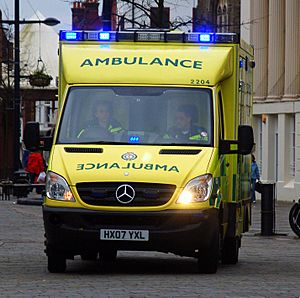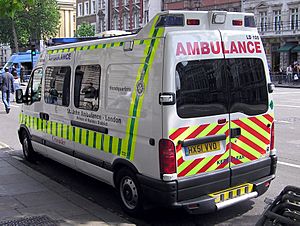Emergency medical services in the United Kingdom facts for kids
Emergency medical services in the United Kingdom are a very important part of the National Health Service (NHS). These services are run by local ambulance groups, called trusts in England and Wales.
Scotland, Wales, and Northern Ireland each have one ambulance service. These are the Scottish Ambulance Service, the Welsh Ambulance Service, and the Northern Ireland Ambulance Service. England has ten different regional ambulance services.
Contents
What Ambulance Services Do
NHS ambulance services have a legal duty to respond to four main types of requests for help:
- Emergency calls to 999 (or 112). These are for serious accidents or sudden illnesses.
- Urgent calls from a doctor. This is when a doctor needs a patient to go to the hospital quickly.
- Urgent calls from one hospital to move a patient to another hospital.
- Major incidents. This means big emergencies like a large accident or a natural disaster.
Ambulance services have become much busier over time. The number of calls has grown a lot in the last 20 years, as you can see below:
| Year | Emergency Calls | Source |
|---|---|---|
| 1994/5 | 2.61 million | |
| 2004/5 | 5.62 million | |
| 2006/7 | 6.3 million |
The work of ambulance staff has also become more complex. In the past, ambulances mainly just took people to the hospital. Some people even joked they were a "Big White Taxi Service." But now, ambulance staff do much more treatment right there with the patient. It's now common for patients to be treated at home and not need to go to the hospital at all.
There's also a service called 111. This is a phone number you can call for medical advice when it's not an emergency. Many ambulance services hire the people who answer these 111 calls. Sometimes, if a 111 call turns out to be more serious than first thought, an ambulance might be sent.
Ambulance trusts also help with non-urgent patient transport. This means moving patients who don't need emergency care, like taking someone from a hospital to a care home. This service is free for patients. Sometimes private companies do this job instead, but it can be a good way for the NHS trusts to earn money.
How Ambulance Services Are Organized
Before 1974, local councils used to run ambulance services. In 1974, these smaller services joined together to form bigger groups covering one or more counties. Then, on July 1, 2006, the number of ambulance trusts was reduced from 29 to 13. They were replaced by larger regional services.
England
Most of the 9 government regions of England have one NHS ambulance trust. The South East region is a bit different. It's covered by two trusts: South Central and South East Coast. The Isle of Wight has a special setup where local hospitals provide the ambulance service.
Here are the main NHS Ambulance Service Trusts in England:
| NHS Ambulance Service Trusts | ||
|---|---|---|
| Ambulance Service | Headquarters | Counties covered |
| East Midlands Ambulance Service NHS Foundation Trust | Nottingham | Derbyshire, Leicestershire, Lincolnshire, Northamptonshire, Nottinghamshire, Rutland |
| East of England Ambulance Service NHS Foundation Trust | Melbourn (near Cambridge) | Bedfordshire, Cambridgeshire, Essex, Hertfordshire, Norfolk and Suffolk |
| Isle of Wight NHS Trust | Newport | Isle of Wight |
| London Ambulance Service NHS Foundation Trust | London | Greater London |
| North East Ambulance Service NHS Foundation Trust | Newcastle-upon-Tyne | County Durham, Northumberland, Tyne & Wear and part of North Yorkshire (Stockton-on-Tees, Middlesbrough and Redcar and Cleveland) |
| North West Ambulance Service NHS Foundation Trust | Bolton | Cheshire, Cumbria, Greater Manchester, Lancashire and Merseyside |
| South Central Ambulance Service NHS Foundation Trust | Bicester | Berkshire, Buckinghamshire, Hampshire and Oxfordshire |
| South East Coast Ambulance Service NHS Foundation Trust | Crawley | East Sussex, Kent, Surrey and West Sussex |
| South Western Ambulance Service NHS Foundation Trust | Exeter | Bristol, Cornwall, Devon, Dorset, Gloucestershire, Somerset and Wiltshire |
| West Midlands Ambulance Service University NHS Foundation Trust | Brierley Hill | Herefordshire, Shropshire, Staffordshire, Warwickshire, West Midlands and Worcestershire |
| Yorkshire Ambulance Service NHS Foundation Trust | Wakefield | East Riding of Yorkshire, most of North Yorkshire (County Council area and York), South Yorkshire and West Yorkshire |
Scotland
The Scottish Ambulance Service is a special health board. It gets its money directly from the Health Department of the Scottish Government. In 2006, this service answered over 520,000 emergency calls.
Scotland also has the only government-funded Air Ambulance service in Britain. It uses two Eurocopter EC 135 helicopters (based in Glasgow and Inverness). It also has two Beechcraft B200C King Air planes (based at Glasgow and Aberdeen).
Northern Ireland
The Northern Ireland Ambulance Service (NIAS) serves all of Northern Ireland. It was started in 1995.
Just like other ambulance services in the UK, it does not charge patients directly for its help. It is paid for by taxes.
NIAS has more than 270 ambulances and over 1,000 staff. They work from 32 stations, 4 control centers, and a training center.
Wales
The Welsh Ambulance Service NHS Trust (in Welsh: Ymddiriedolaeth GIG Gwasanaethau Ambiwlans Cymru) began on April 1, 1998. It has 2,500 staff who provide ambulance and related services to the 2.9 million people living in Wales.
Its main office is at HM Stanley Hospital in St Asaph, Denbighshire. The service is split into three regions:
- Central and West Region: Based at Ty Maes Y Gruffudd, Cefn Coed Hospital, Cockett, Swansea
- North Region: Based at H.M.Stanley Hospital, St Asaph, Denbighshire
- South-East Region: Based at Caerleon House, Mamhilad Park Estate, Pontypool
Private Ambulance Services
Private ambulance services are becoming more common in the UK. They often provide medical help at large events, either alongside or instead of volunteer groups. Event organizers might choose a private company because they are more available during the week. They might also offer a wider range of skills, like having qualified Paramedics.
The most common job for private ambulances is non-urgent patient transport. Many NHS trusts and hospitals use private companies for these tasks. NHS ambulance services might also pay private ambulances to help answer some of their 999 emergency calls.
All ambulance companies, including NHS trusts and private ones, must follow the same laws. This means a private ambulance must have the same equipment and staff with the same training as an NHS ambulance.
Volunteer Ambulance Services
In most of the United Kingdom, the main volunteer ambulance services are the British Red Cross and St John Ambulance. In Scotland, the main volunteer group is St Andrew's First Aid. The Order of Malta Ambulance Corps. can sometimes be found in Northern Ireland. These groups have been providing medical help in the UK for over 120 years, even before government services existed. They helped during both World Wars.
Besides training and teaching first aid, these groups mainly provide ambulance cover at events. They act as an extension of their first aid services.
They can also treat and transport some types of patients to the hospital. However, for very serious incidents like a cardiac arrest, they would likely call the main ambulance service. This is all arranged through agreements with the local ambulance service.
Both the British Red Cross and St John Ambulance also provide "reserve" or "support" help to some NHS ambulance trusts. This means their volunteer crews (or sometimes paid staff) will respond to 999, urgent doctor calls, or patient transport calls for the NHS trust. The NHS trust pays the volunteer organization for this help. This support is often used during major incidents, when many staff are absent, or when there are a lot of calls. In some areas, volunteer crews regularly help out the full-time NHS staff.
These volunteer organizations have also provided help to the public when NHS ambulance staff have gone on strike.
Related pages
- Air Ambulances in the United Kingdom
- Blues and twos
- National Health Service
- Fire service in the United Kingdom
- Former UK Ambulance Services
- British Association for Immediate Care (BASICS)
Images for kids
-
An East of England Ambulance Service Rapid Response Vehicle (RRV)
See also
 In Spanish: Servicios médicos de emergencia en el Reino Unido para niños
In Spanish: Servicios médicos de emergencia en el Reino Unido para niños










